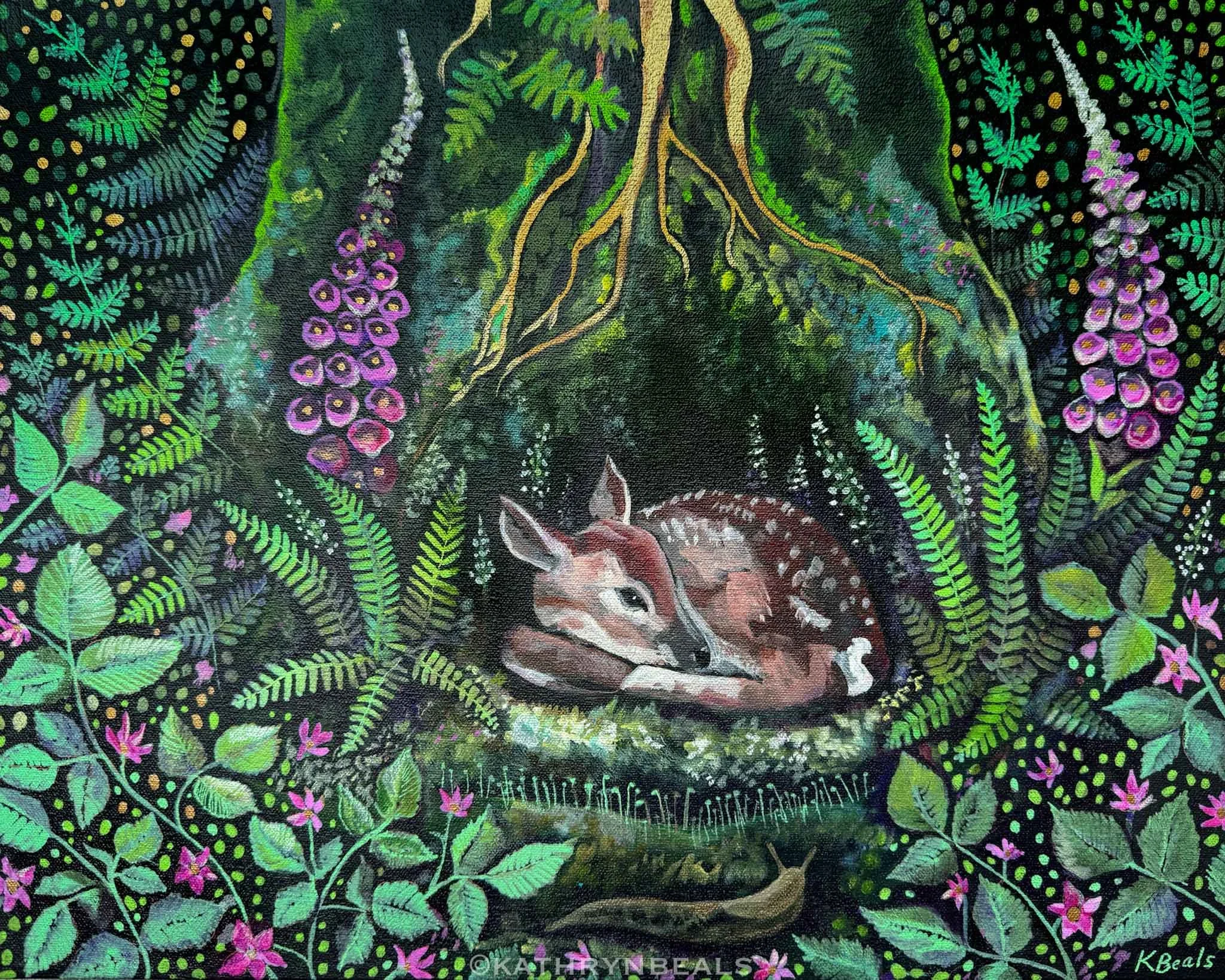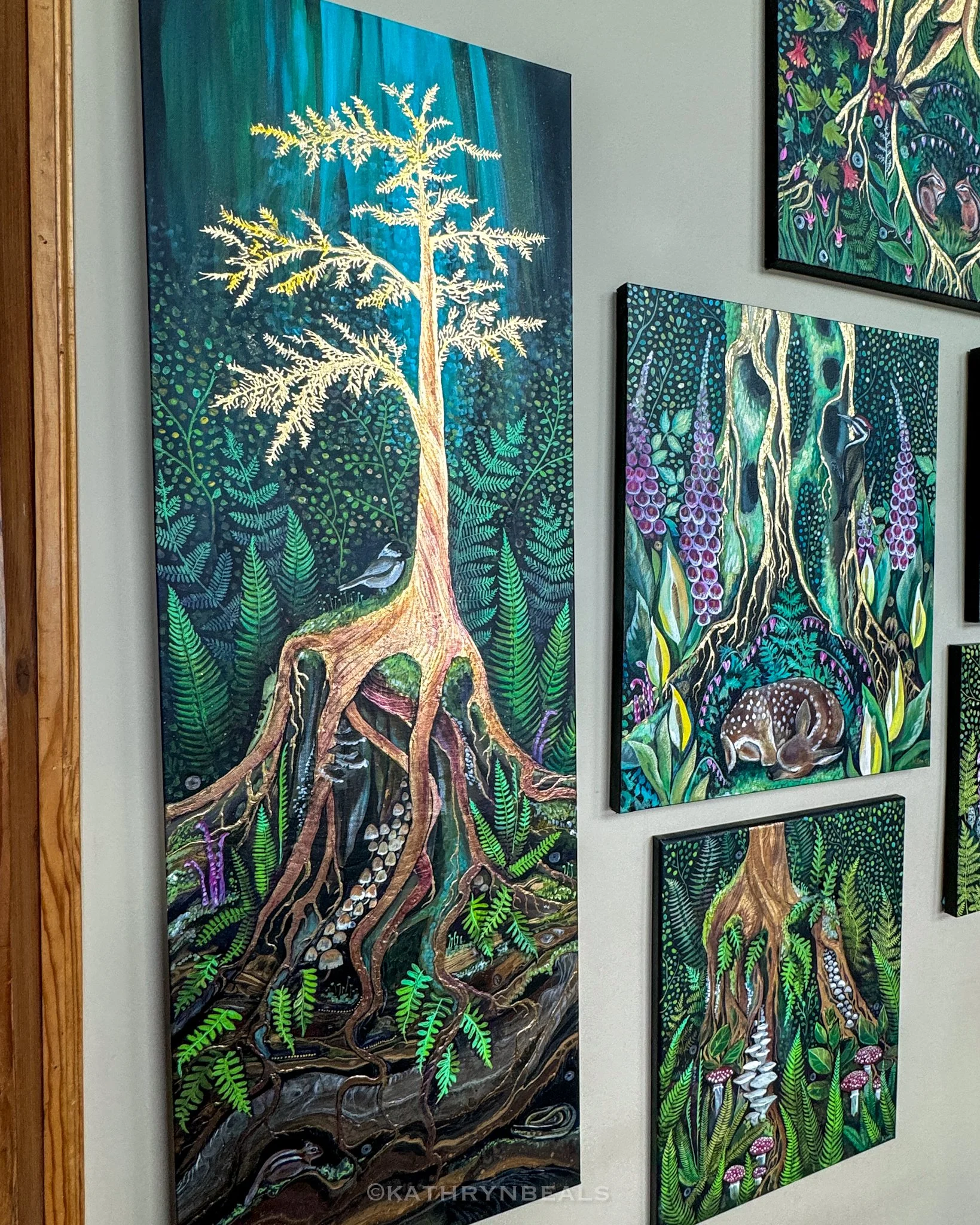The Forest Floor Series
Read about the series below. The remaining originals have been moved to the Original Landscapes gallery with the newest addition, Secret.
I grew up in a remote northern community on Vancouver Island, and its magical forests imprinted on me for life. I drew trees and plants as a child, and made this pencil crayon drawing of a nurse log when I was 13.
As a very young child, I believed that the woods were full of fairies, and it was one of the first things that made me curious about the forest. As l grew up, I learned everything I could about trees. I put myself through forestry school growing seedling spruce and pines in a nursery, and later planting them in northern Alberta. I’ve mapped forests from a helicopter, traced aspen lineages from the roots, and analyzed oak DNA in a lab. 30 years since this drawing, my life studying trees has now come full circle, back to painting them.
Over time, my literal belief in fairies has evolved into a reverence for the forest, and all the hidden and beautiful things we have yet to understand about it. Each year, we learn more about the ways the parts of a forest are connected, and how much we need nature.
My pencil crayon drawing from 1993
The Forest Floor Series
Though I took a lot of artistic license in this series with botanical correctness, I wanted it to honour my childhood love of the forest. The paintings in this series tell an ongoing story about life cycles in the forest: The small white circles hidden in the shadows are my childhood fairies.
Genesis - This is a reprisal of my original nurse log illustration above, this time using acrylic paint and metal leaf. The decaying nurse log supports biodiversity and new life on the forest floor.
Embrace - A newborn fawn is hidden in the shadow of a nurse log while its mother forages nearby. The moss covered stump is surrounded by foxgloves, bleeding hearts and skunk cabbage, and a pileated woodpecker looks on.
Commencement - This school of baby salmon are ready to leave their forest stream bottom and venture to the ocean, before they return in a few years to spawn. In the background, ancient cedars watch over them, with only remnants of their own nurse logs under their strong roots.
Union - The most whimsical of the series, this piece honours the way I saw the forest as a little girl. This chipmunk wedding is surrounded by red columbine flowers, and attended by the Anna’s hummingbird, the only BC hummingbird species that does not migrate. Pink fairy slipper orchids and false Solomon’s seal adorn the forest floor, as the golden roots of the seedling hemlock embrace them. Because I believed in fairies as a little kid, you might see the light of a fairy or two in the shadows.
Resting Place - Years later, the deer returns to the forest floor, where it is entered back into the nutrient cycle by the work of forest decomposers. This piece celebrates the diversity of fungi and their important role in the life cycle.
The Watchers - Ravens hold a sacred role in mythology and in the biology of the forest floor. These important scavengers aid in the forest life cycle, along with forest decomposers such as fungi and invertebrates. Due to the action of bears, eagles and ravens, nitrogen in many coastal trees can be traced to salmon. The ravens perch on a nurse log surrounded by salal and huckleberry, against a backdrop of ancient cedars.
Returning - A banana slug looks on at the legacy of a grizzly bear, whose skull now rests in front of the nurse log on the forest floor, surrounded by mushrooms and coralroot.
Emerging - A hemlock seedling sprouts on the decaying stump of another fallen tree. These hidden life cycles support the beauty of the forests we see around us.
What is a Nurse Log?
A nurse log is a fallen or cut log that supports the growth of new trees and plants as it decays. A new seedling sprouts on the decaying log, and stretches down roots as it grows, often enveloping the original stump. Nurse logs are beautiful, unseen supporters of biodiversity on the forest floor.
Our island forests are recovering from heavy logging in the 1800s, and the second growth forest is full of nurse logs. On many nurse logs, you can see the original evidence of logging and fires on the stump. A closer look also reveals a vast diversity of mosses, mushrooms, plants, insects and animals, all supported by the nutrients of the original tree.





















